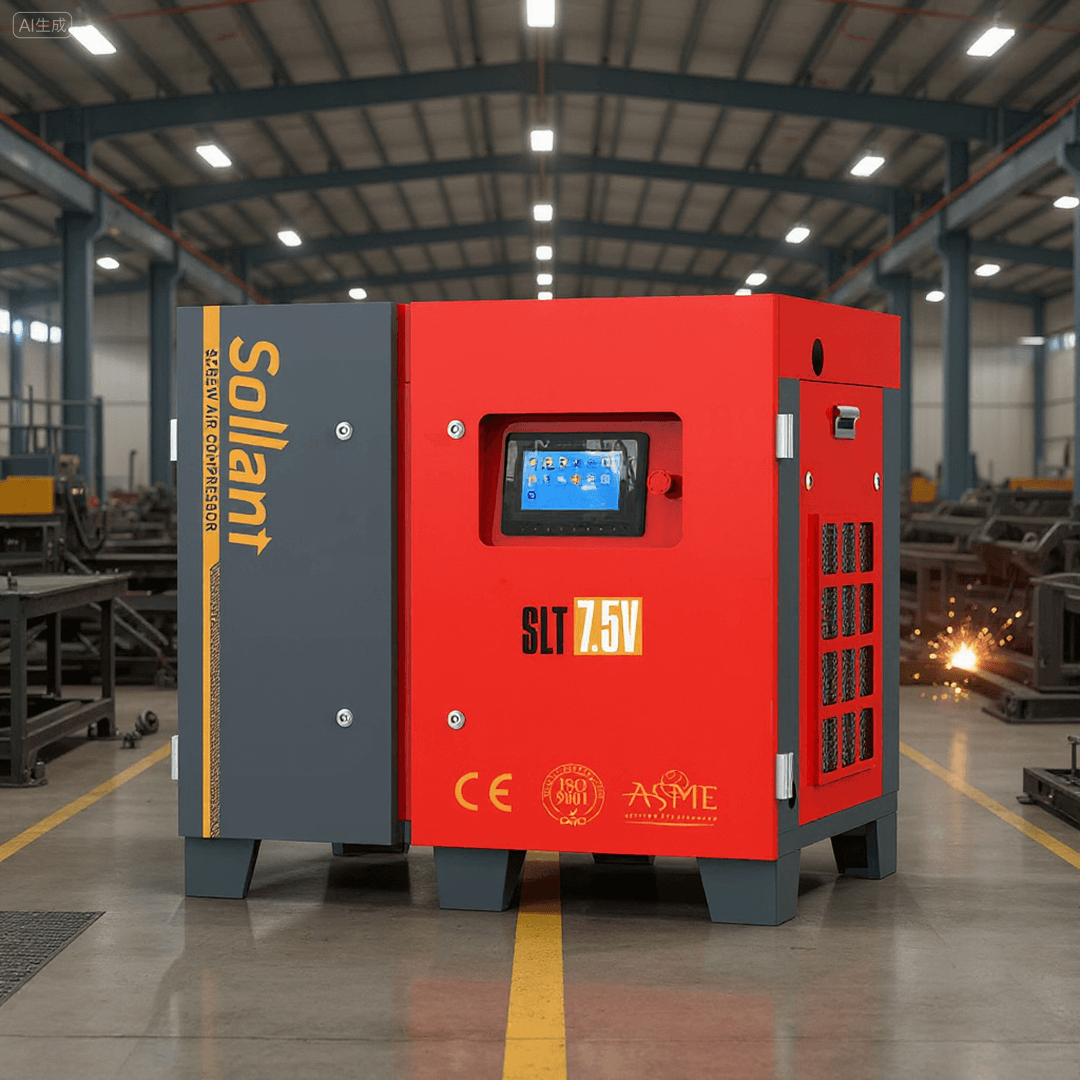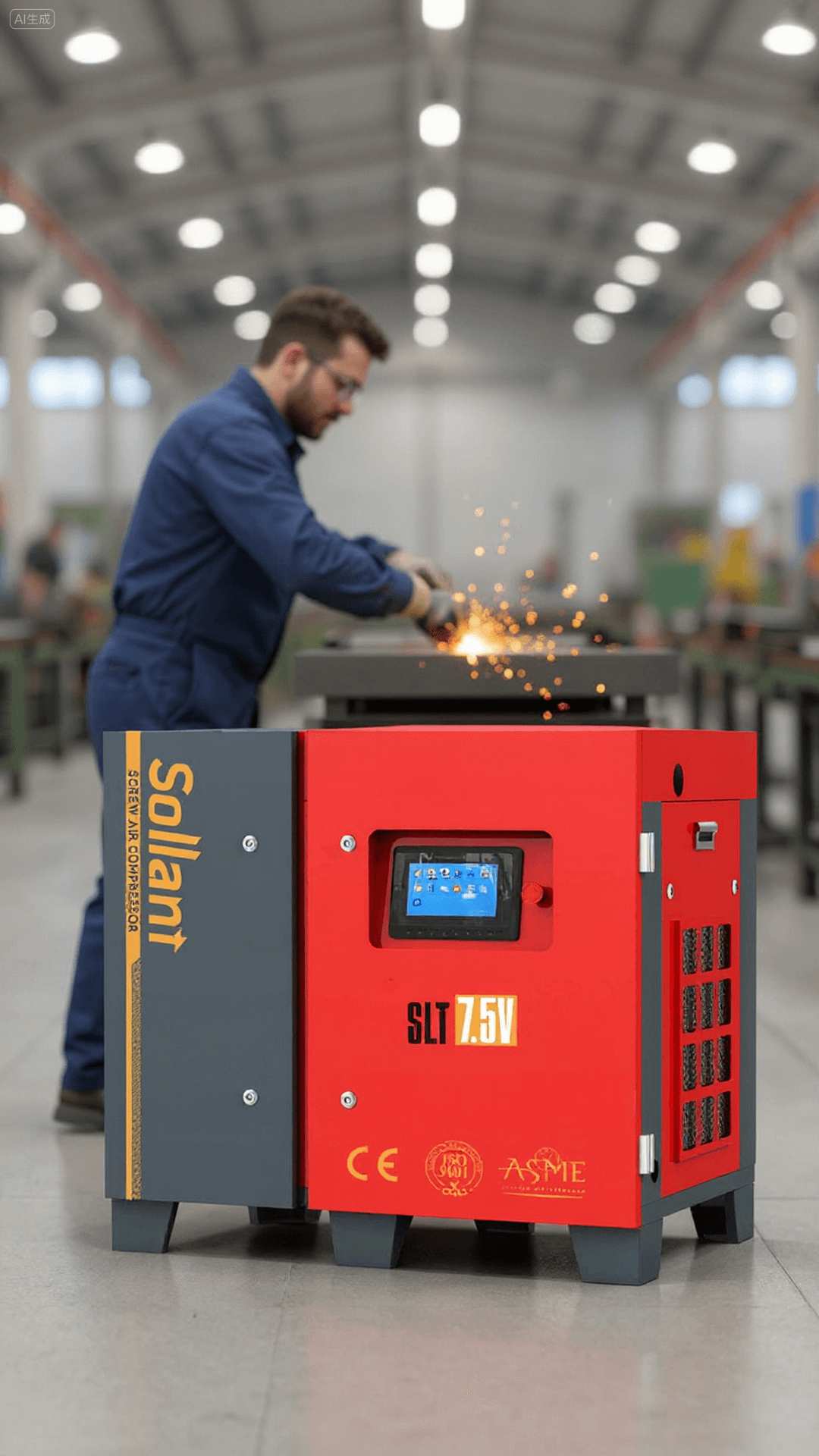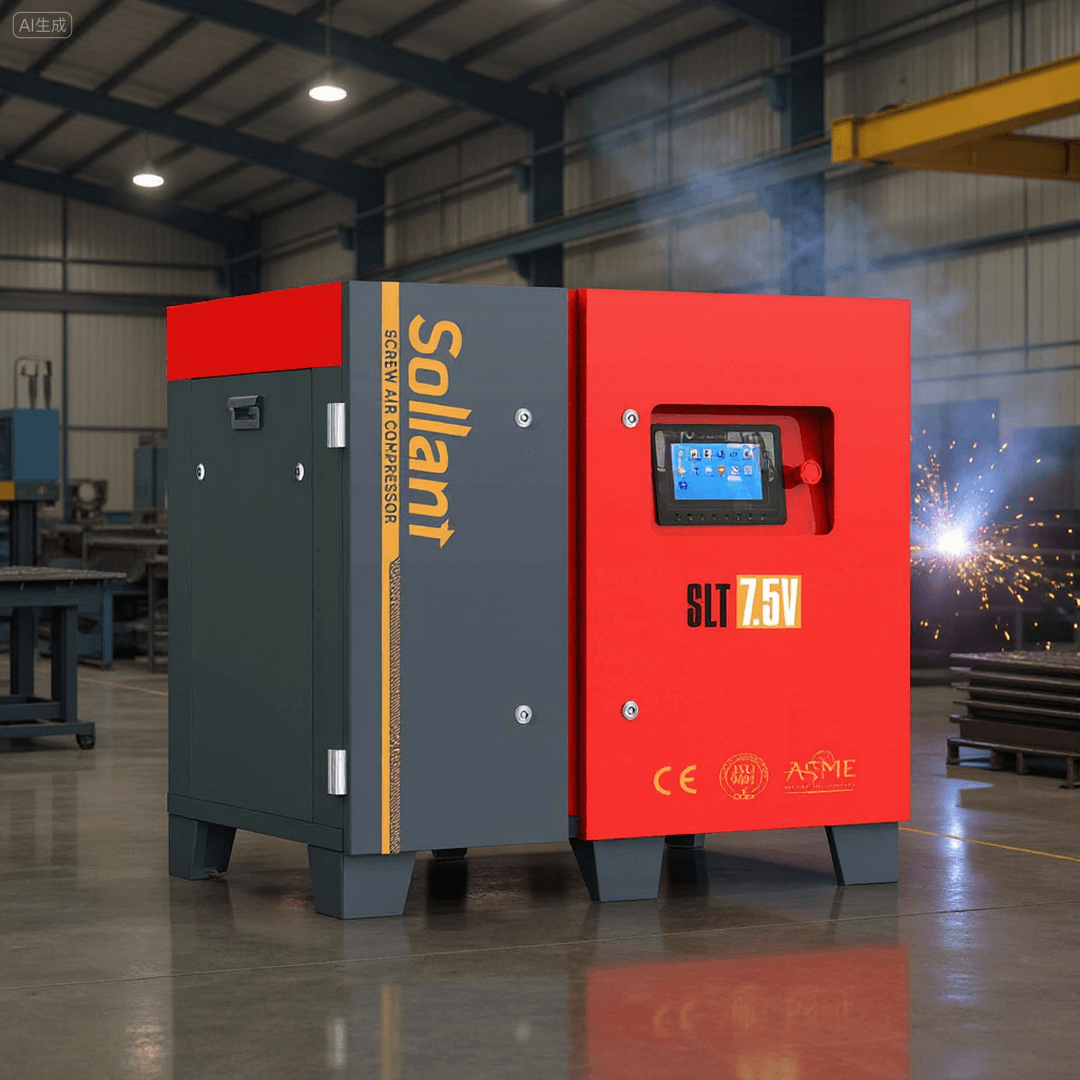The causes of high oil content in screw air compressors due to low exhaust pressure

You may notice high oil content in Screw Air Compressors when low exhaust pressure occurs. This happens because low pressure disrupts the oil-gas separation process. Oil droplets escape with the compressed air instead of settling properly. You need to understand this mechanism to prevent damage and costly downtime. Sollant’s advanced design helps you maintain stable pressure and cleaner air output.
Table of Contents
Key Takeaways
Low exhaust pressure disrupts oil-gas separation, leading to high oil content in compressed air. Regularly check and maintain your system to prevent this issue.
Oil separator problems often cause oil to escape into the air stream. Replace or reinstall separators as needed to ensure efficient operation.
Inspect your exhaust system for leaks. Regular checks can help you catch leaks early, saving you from costly repairs and maintaining stable pressure.
Match your compressor output to actual air demand. This practice reduces cycling and keeps exhaust pressure stable, minimizing oil carryover.
Follow a strict maintenance schedule. Regularly change filters, check oil levels, and clean components to keep your compressor running efficiently and reduce oil contamination.
High Oil Content Causes
Oil Separator Issues
You may notice that oil separator problems often cause high oil content in screw air compressors. When the separator fails, oil escapes into the compressed air. You can spot this issue if you see visible oil mist at discharge points or a gradual rise in differential pressure across the separator. If the separator collapses, you may experience a sudden spike in pressure or even a shutdown. Downstream equipment can foul quickly, leading to costly repairs.
Common Oil Separator Problems | What Happens | What You Should Do |
|---|---|---|
Separator element failure | Oil enters air stream, causing contamination | Replace separator element |
Improper installation | Oil bypasses separator, increasing oil loss | Reinstall correctly |
Aging or clogged filter | Oil droplets escape, raising oil content | Change filter regularly |
Sollant’s advanced oil separator design uses optimal plate angles and precise spacing. These features improve oil separation efficiency, even when exhaust pressure drops. The separator applies Stokes Law to maintain laminar flow, helping oil droplets settle out of the air. You benefit from longer separator life and cleaner compressed air.
Tip: If you need to top off oil frequently, check the separator first. This simple step can prevent bigger problems.
Exhaust System Leaks
Leaks in the exhaust system can lower exhaust pressure and increase oil in the air. You may find leaks at loose valves, cracked pipes, or worn gaskets. These leaks waste air and allow oil mist to escape before proper separation. Regular inspection helps you catch leaks early and avoid hidden costs.
Inspection Practice | Benefit |
|---|---|
Check valves and connections weekly | Prevent air and oil leaks |
Monitor for unusual symptoms | Resolve issues quickly |
Professional checks | Detect leaks before they cause damage |
Sollant compressors feature durable seals and robust connections. These components resist leaks and maintain stable exhaust pressure. You save money by reducing wasted air and oil.

Load Imbalance
Load imbalance happens when the compressor’s output does not match your actual air demand. If you use a large compressor for a small job, the system may cycle between loading and unloading. This cycling keeps exhaust pressure low and disrupts oil separation. You may see oil carried over into the compressed air.
Explanation | Solution | |
|---|---|---|
Minimum pressure valve failure | Valve opens too soon, raising oil mist | Repair or replace valve |
Poor tank design | Oil mist concentration rises | Upgrade tank design |
Oil escapes with airflow | Drain oil to normal level | |
Damaged check valve | Oil flows back into separator | Replace valve |
Blocked oil return line | Oil cannot return, escapes with air | Clear blockages |
Sollant offers compressors with real-time speed adjustment and closed-loop pressure control. These features match output to demand, keeping pressure stable and reducing oil loss.
Note: Always set your compressor to match your actual air needs. This practice keeps oil content low and equipment running smoothly.
Intake Problems
Intake problems can also lead to high oil content. If you overfill the oil, use poor quality oil, or mix brands, the separator may clog or fail. Low usage and improper exhaust temperature can cause water vapor to condense, mixing with oil and raising contamination. Incorrect pipeline installation may cause backflow, worsening the issue.
Excessive refueling deteriorates oil separation.
Poor quality oil allows foam to enter the separator.
Mixing oil brands clogs the separator.
Low usage and wrong temperature cause water vapor condensation.
Improper pipeline installation leads to backflow.
Sollant’s intake filtration systems use high-density filter materials and nano-plating. These filters exclude contaminants before oil enters the system and remove them from used oil. You get better filtration, less resistance, and longer equipment life. Installing filters in parallel and using high beta ratio filters (over 1,000 for 2 to 10 microns) ensures excellent oil cleanliness.
Tip: Use only recommended oil and filters. Regular maintenance keeps your compressor efficient and reduces oil contamination risks.
Screw Air Compressors Troubleshooting
Pressure Testing Steps
You can identify low exhaust pressure and high oil content in screw air compressors by following a systematic pressure test. Start by cleaning the equipment to remove all foreign matter. Hold the pressure for at least 30 minutes during inspection. Apply bubble solution to the casing to check for leaks. Make sure there is no deformation or leakage. Use air or nitrogen at 1.1 times the maximum allowable working pressure and hold for 30 minutes. Confirm that the pressure vessel shows no bulging, elongation, or leakage. These steps follow ASME standards and help you spot issues before they affect your compressed air quality.
Tip: Accurate pressure testing helps you catch problems early. High oil levels or low exhaust pressure often mean oil is entering the air stream. You can use the table below to understand what each issue means.
Issue Identified | Explanation |
|---|---|
Excessive oil can enter the gas stream if the oil level is too high, leading to increased oil in the exhaust. | |
Insufficient exhaust pressure can increase the oil burden, resulting in oil appearing in the exhaust. |
Intake and Rotor Inspection
You should inspect intake and rotor components regularly to prevent oil contamination. Check air filters before each use and replace them if needed. Clear any obstructions from the air intake. Clean or replace filters based on their condition. Always check oil levels before operation. Change oil according to manufacturer guidelines. Inspect oil for contamination, such as metal particles or dirt. Rotor wear or damage can cause misalignment and increased clearance, which reduces oil separation efficiency. This leads to higher oil contamination in the compressed air.
Check air filters frequently.
Clear obstructions from intake.
Clean or replace filters.
Check oil levels before operation.
Change oil regularly.
Inspect oil for contamination.
Load Matching Solutions
You can reduce oil content by matching compressor output to your actual air demand. Oil-lubricated compressors need downstream filtration and treatment. Oil-free compressors eliminate the risk of oil contamination and offer lower operating costs. Sollant’s intelligent control system provides real-time monitoring of temperature, pressure, current, and frequency. The latest generation inverter ensures constant pressure and temperature control, reducing energy use and maintaining air supply efficiency. Sollant’s technical support helps you implement these solutions for your screw air compressors, ensuring reliable operation and cleaner compressed air.
Solution Type | Effectiveness in Reducing Oil Content | Additional Benefits |
|---|---|---|
Oil-lubricated Compressors | Requires downstream filtration and treatment | Can meet Class 1 or Class 2 air quality with proper setup |
Oil-free Compressors | Eliminates risk of oil contamination | Lower operating costs, smaller size, environmental benefits |
Note: Sollant’s after-sales support and custom solutions help you diagnose and repair issues quickly. You can rely on their expertise for long-term reliability.
Solutions and Preventive Measures
Stabilize Pressure
You can stabilize exhaust pressure in screw air compressors by following a few practical steps. Stable pressure keeps oil separation efficient and protects your equipment. Start by accessing the control panel and entering the menu options. Find the user parameters and locate the loading and unloading pressure settings. Adjust the loading pressure to your minimum requirement, such as 5 bar. Set the unloading pressure about 2 bar higher than the loading pressure, but do not exceed the rated pressure of your compressor. Save the settings and avoid running the compressor at low pressure for long periods.
Step | Action | Result |
|---|---|---|
1 | Access control panel | Enter menu options |
2 | Find user parameters | Locate pressure settings |
3 | Adjust loading pressure | Set to minimum requirement |
4 | Set unloading pressure | Keep 2 bar higher than loading pressure |
5 | Save settings | Maintain stable pressure |

Sollant compressors make this process easier with advanced controllers and real-time monitoring. You get consistent pressure, which helps reduce oil carryover and keeps your compressed air clean.
Tip: Always check your pressure settings after maintenance or repairs. Stable pressure means better oil separation and longer equipment life.
Reduce Oil Content
You can lower oil content in screw air compressors by using smart operating practices and quality parts. Avoid running compressors at light loads. Light loads often cause oil to escape into the air stream. Consider using a variable speed drive compressor to match air supply with demand. This adjustment keeps oil separation efficient and reduces waste.
Regular maintenance of oil separators, filters, and drains is essential. Clean and replace these parts as needed to keep oil out of your compressed air. Install high-quality filtration systems downstream to protect sensitive equipment and processes.
Sollant genuine parts, especially oil-water separators, help you achieve lower oil carryover rates. These separators use patented multi-stage filtration to trap contaminants. Only clean water leaves the system, and oil stays out of your air supply.
Use variable speed drive compressors for better matching.
Maintain oil separators, filters, and drains regularly.
Install high-quality downstream filtration.
Choose genuine Sollant parts for efficient oil separation.
Note: Using genuine Sollant parts ensures your compressor runs efficiently and keeps oil levels within safe limits.
Regular Maintenance
You can prevent oil contamination and equipment failure by following a regular maintenance schedule. Inspect filters, lubricants, and cooling systems often. Change the oil filter every 2,000 run hours to keep dirt and abrasives out of the lubricant. Check air filters weekly to maintain efficiency and extend lubricant life. Test oil every 2,000 hours to prevent corrosion and varnish. Clean aftercoolers and oil coolers to avoid overheating and damage. Change the air/oil separator every 4,000 hours or once a year to minimize oil carryover.
Maintenance Task | Frequency | Benefit |
|---|---|---|
Change oil filter | Every 2,000 hours | Keeps dirt out of lubricant |
Check air filters | Weekly | Maintains efficiency |
Test oil | Every 2,000 hours | Prevents corrosion |
Clean coolers | Regularly | Avoids overheating |
Change air/oil separator | Every 4,000 hours or annually | Reduces oil carryover |
Sollant offers preventive maintenance programs and advanced filter technology. You get support services that help you keep your screw air compressors running reliably. Regular checks and genuine parts extend equipment life and reduce oil loss.
Check and replace consumable parts regularly.
Maintain proper oil levels in oil-injected systems.
Drain the air compressor system to manage moisture and prevent corrosion.
Tip: Set reminders for maintenance tasks. Consistent care keeps oil contamination low and ensures your compressed air stays clean.
Low exhaust pressure leads to high oil content in screw air compressors. You can prevent this by checking your system regularly and using quality parts. Sollant’s solutions help you keep your air clean and your equipment reliable.
Sollant Solution | How It Helps |
|---|---|
Precision Filter | Removes oil and impurities for cleaner air |
Adsorption Dryer | Eliminates moisture and pollutants |
Reduces downtime and boosts performance |
Use the correct oil base for your compressor.
Check oil levels weekly.
Drain moisture from the system often.
You can trust Sollant for expert support and reliable products.

FAQ
What causes high oil content in screw air compressors?
You often see high oil content when exhaust pressure drops. This disrupts the oil-gas separator. Oil droplets escape into the compressed air. Regular checks and proper maintenance help prevent this issue.
How can you reduce oil carryover in your compressor?
You can reduce oil carryover by maintaining stable exhaust pressure. Use genuine oil separators and filters. Clean or replace these parts on schedule. Monitor your compressor’s pressure settings for best results.
Why does low exhaust pressure increase oil contamination?
Low exhaust pressure increases airflow speed. This makes it harder for the oil-gas separator to work. Oil droplets pass through and enter the air stream. You should keep pressure within the recommended range.
What maintenance steps help prevent oil leakage problem?
You should inspect seals, gaskets, and connections regularly. Replace worn parts quickly. Use only recommended lubricants and filters. Follow a strict maintenance schedule to avoid oil leakage problem and keep your system efficient.
When should you replace the oil separator element?
Replace the oil separator element every 4,000 hours or once a year. If you notice increased oil content or pressure drop, change it sooner. Always use parts that match your compressor’s specifications.


